How We Abandoned our Landscape Art
Milwaukeeʼs parks are credited to Frederick Law Olmsted but have abandoned his vision. Part I of a series.
Fredrick Law Olmsted handpicked the species and placement of every tree you see in this picture. He created the winding paths that never seem to end. It doesn’t matter where you stand or how you move. All the views are poised and balanced. Light dances in the foreground as the scene sweeps out to infinity.
Gradually and silently the charm comes over us,” Olmsted wrote, “we know not exactly where or how.”
This park, The Wade Lagoon in Cleveland, was recently restored and is maintained according to Olmsted’s original plans. Nothing stops the eye. The scenery is layered and porous, leaving the impression of “an enlarged sense and bounteousness of nature,” as Olmsted noted. It wraps around and sweeps you away.
Olmsted grew up in turbulent times. As a young man (and a journalist) he traveled and wrote about the slave states in America. Meanwhile the population of New York City quadrupled between 1821 and 1855. Workers and slaughter houses were filling and fouling cities a half a century before the germ theory of disease and the practice of sanitation became widespread. The citizens of great cities, which Olmsted realized were great engines of opportunity for all kinds of people (including women), desperately needed relief from claustrophobic conditions of raging capitalism and the industrial revolution.
He built the parks to foster an egalitarian democracy. “All classes [are] largely represented, with a common purpose,” Olmsted wrote in 1870, “each individual adding by his mere presence to the pleasure of all others, all helping to the greater happiness of each. You may thus often see vast numbers of persons brought closely together, poor and rich, young and old, Jew and Gentile.”
In other words, Olmsted was not interested in letting nature have its way. More than ten million cartloads of soil and rocks were carried out of Central Park. He used more gun powder to shape the park than was used in the Battle of Gettysburg, and planted more than four million trees, shrubs and plants. In Milwaukee, Olmsted filled in a ravine in Lake Park to make another meadow.
His parks were not “natural,” like the reconstruction of the prairie the Urban Ecology Center is doing along the Milwaukee River. They were pure artifice that takes a lot of work to maintain.
Some of the pods of Lake Park
It didn’t take long for the spaces between the trees to fill in, for Lake Park to become overgrown. As long as I can remember Olmsted’s parks in Milwaukee, touted in all promotional materials for the city, they have been just a series of anonymous plots of parkland, pods of grass that do nothing other than hold walls of weedy trees at bay.
When was the last time you saw a professional forester doing anything in a Milwaukee Park? We not only lost all of Olmsted’s individual brush strokes, we lost the big picture. Originally Lake Park was all about the lake. Olmsted’s company was commissioned to turn this spot into an overlook, a wide open vista of Lake Michigan.
According to the Milwaukee Park Commission reported in 1892.
“In selecting this noble promontory, the Commissioners were actuated to give back to the people of Milwaukee the only chance left them to reach the lake without being compelled to cross railway tracks. They have always considered the lake the most beautiful feature of Milwaukee’s surroundings, and the fact the lake shore from St. Francis on the south to the water works on the north, had fallen into the hands of private parties or of corporations, inspired them to secure this magnificent lake frontage at all hazard. The park … overlooks the beautiful bay of Milwaukee clear to South Point.”
Lake Park around 1890
Americans followed Olmsted’s curvy lines and kidney-shaped ponds to cul de sacs and golf courses in the suburbs. These pods, now stripped of his artistry, became a model for office parks and estates in River Hills and Mequon. The only thing left of Olmsted’s plan are the bones.
| Lake Park | Mequon Wisconsin Photos: Google Earth |
Perversely, Olmsted’s park became the model for buffers between private property that not only separate the classes, but neighbors as well. Olmsted’s picturesque vista for the masses morphed into a series of lonely voids.
No one is tending Olmsted’s trees because no one knows what or where they are. Still, we continue to wear Olmsted as a badge of honor. The Lake Park Friends’ website goes on about how he took advantage of its proximity to Lake Michigan, and how Olmsted’s “sinuous paths lead to surprising vistas.”
But there is nothing left of Olmsted’s ideals except the curvy roads and paths that almost never lead to a surprising vista in Lake Park, Riverside Park or Washington Park, the three parks whose design is credited to him. You can’t even see Lake Park’s namesake lake except for a small patch on Wahl Avenue where a vigilante, chain-saw wielding homeowner living across the street carved out his view of Lake Michigan.
The Cleveland example suggests it is possible to restore Olmsted’s original vision, which might be a worthy goal for the leaders of Milwaukee County Parks, one arguably more important than where to put the next splash pad or water slide. As it is, we are left with Olmsted’s skeleton, stripped of all his scenic beauty and democratic ideals.
Coming next: What happened to the Art Museumʼs Kiley Landscape?
In Public
-
The Good Mural
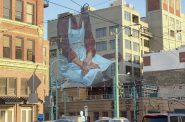 Apr 19th, 2020 by Tom Bamberger
Apr 19th, 2020 by Tom Bamberger
-
Scooters Are the Future
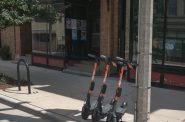 Dec 19th, 2019 by Tom Bamberger
Dec 19th, 2019 by Tom Bamberger
-
Homeless Tent City Is a Democracy
 Aug 2nd, 2019 by Tom Bamberger
Aug 2nd, 2019 by Tom Bamberger


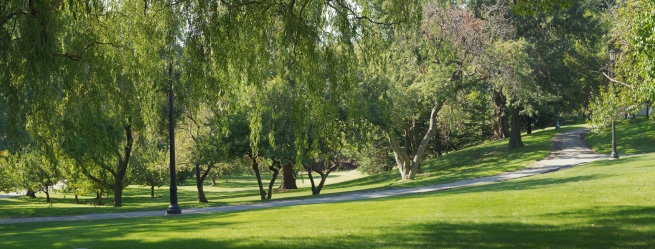


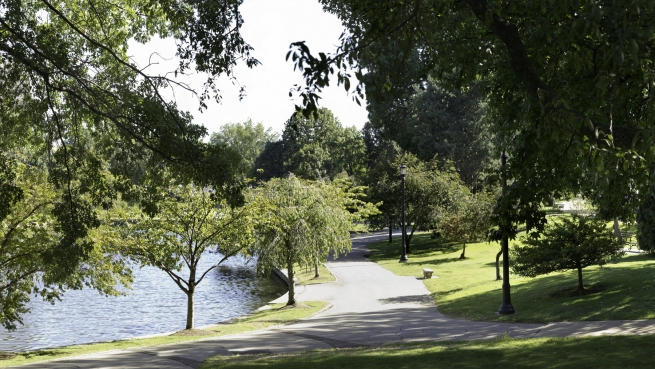

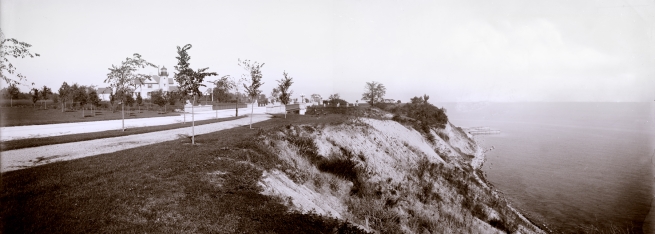
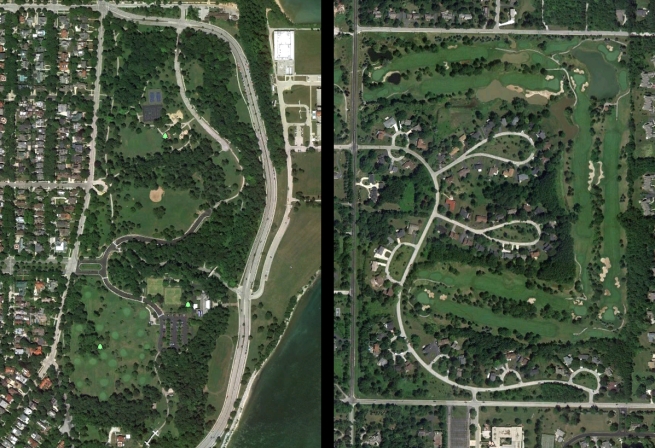















Thanks, friend!
Hey Tom, get off my lawn. It’s only a palpable metaphor for what’s happened to the values that inspired egalitarian greenspace. Scotty will sell it for you though.
It is possible for a park designed/built by Olmstead & his business to evolve over time. Change does not necessarily represent decline.
Your article is spot though about how those parks in Milwaukee have fared. However, Lake Park is much better off with the incremental improvements of the Lake Park Friends. Many things have changed surrounding the Park including the construction of the Water Works, Lincoln Memorial Drive & the ubiquity of cars/traffic. There is no money for, or sense to, recreate a park built specifically for another era & maintain it as static sculpture.
With that said, many of Olmstead’s original designs should be restored. The issue with the lack of actual Lake Michigan views strikes me as especially sad. Look to Kilbourn Park Downtown and there is also a huge wall of trees; 50+ years of County Parks mismanagement doesn’t discriminate.
Well said, Tom. And I can’t wait to read what you have to say about the Art Museum’s hedges gone wild….doubled in volume in the brief 11-some years since their planting. Unchecked they’ll reach the brise soleil by 2032, just in time for the 30th anniversary flap.
Jesse H.
Just because the County is broke is not the end of the story. It’s about us too. The County after all is not an independent body.
And there are other potential sources of funding for parks. What’s lacking is vision — knowledge or what was and what’s possible. I still believe where there is a will there is way. That’s how we got Olmsted here in the first place.
The Olmstead park system is probably the city’s biggest and most beautiful asset and it is sad to see it neglected for years especially by the park slashing county executives the likes of Scott Walker. Hopefully the future holds a bigger commitment to maintaining these great assets.
When I lived in Milwaukee, I used to jog along the lake from Brady/Prospect south down to the Summerfest grounds than back north along Lincoln Memorial up the hill to come back south through Lake Park and would tend to agree that the portion of the route through Lake Park was probably the most underwhelming. In St. Louis, a consortium of public and private groups is spending $380 million to overhaul the Gateway Arch grounds for its 50th anniversary in 2015, including building a “lid” over the below grade portion of I-70 west of the Arch somewhat idiotically sited in such a way as to form an inhospitable barrier separating the downtown from the Arch itself. At least Milwaukee killed the Lake Freeway and didn’t screw up its lakefront by making the same sort of mistake that was made here; fixing up Lake Park wouldn’t cost an arm and a leg, either.
Spoken like a true east side liberal. Get a grip of reality. There is more to the world than your little slice of world on the wacko east side. This site is more biased and narrow minded every time I read it.
Thank you for this interesting article. It is my personal belief that few people realize that a Park is designed, just as a great work or art, a beautiful interior or important building. When we go about restoring our lake views (remembering the Lake is why we are here!) and Parks to their original state by prudently trimming and removing unintended trees and bushes, I believe some people find it very difficult, because they are living things. Knowing there was a design scheme, especially in Lake Park by such a renowned landscape artist as Olmstead, may ease the worries of people who share that view. Thank you Tom.
Tom, thanks. We have an opportunity to make a good park stunning. And it needn’t be costly beyond our means. The goal here is a landscape accessible to all – free – not the forbidding cost of a Buck’s game. And maybe that’s the problem; the fear of spending money for “frivolous” assets.
The cure to the fear might be a vision. It was like that the evening a presenter sank the battleship that was looming onto our lakefront – her memorable power point.
Someone handy with graphics might do a mock up of what the various vistas would do to the sight lines, and maybe thereby inspire a leader to come forward and help us all pull it together. The money, by the way, is waiting for action from a referendum that political types would like us to forget: Nov. 4, 2008.
The “battleship” was actually a heavy cruiser (USS Des Moines CA-134), and while I am interested in such ships, I’m glad that particular proposal was shot down, and there was another ship in that class saved as a museum ship in Massachusetts, anyway. Not including the USS Arizona Memorial in Pearl Harbor, there are a total of eight battleships preserved as museum ships in the US, as well as five aircraft carriers, so there is not exactly a shortage of these kinds of ships to visit, as long as one is willing to make the journey to the Atlantic, Pacific, or Gulf Coast to do so.